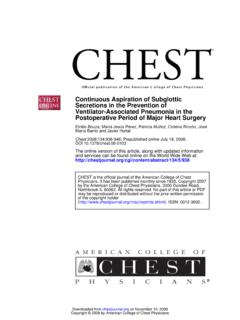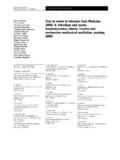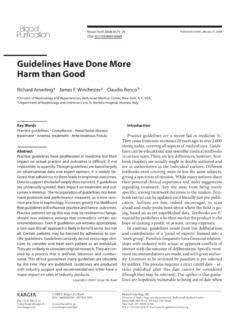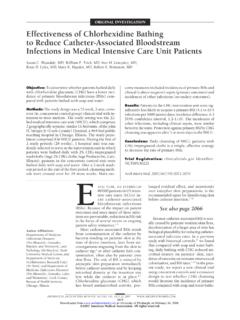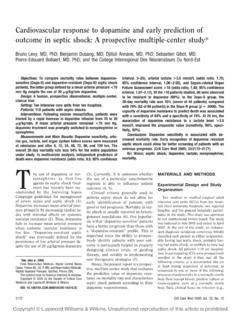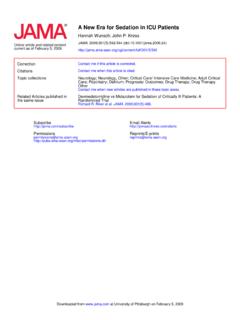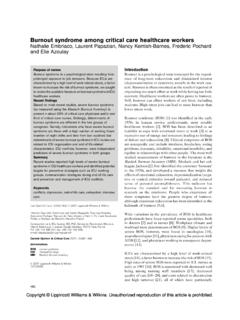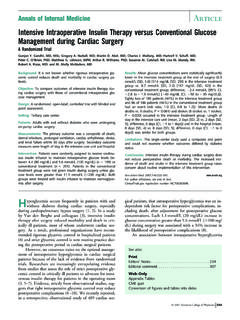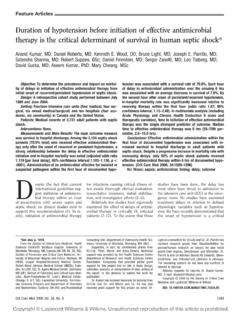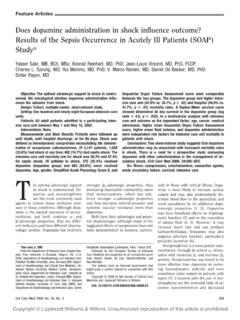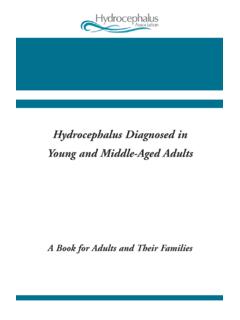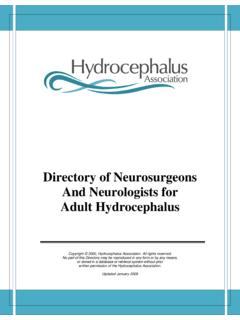Transcription of Use of Prophylactic Anticonvulsants in Neurologic …
1 REVIEWUse of Prophylactic Anticonvulsants in NeurologicCritical Care: A Critical AppraisalKenneth C. Liu Anish BhardwajPublished online: 1 September 2007 Humana Press Inc. 2007 AbstractSeizures are commonly encountered in thesetting of brain injury in Neurologic critical care. Thoughseizure prophylaxis with the use of antiepileptic drugs isfrequently utilized in variety of brain injury paradigms, it isoften not based on evidence and is controversial. Signifi-cant difficulties arise from interpretation of supportingliterature due to lack of definitions for , variable end points with seizure prophylaxis, as wellas methodologic inconsistencies for seizure detection.
2 Thisdescriptive review summarizes the existing literature on theuse of Prophylactic Anticonvulsants in clinical paradigmscommonly encountered in Neurologic critical care andhighlights the important controversies concerning their Neurologic critical care Anticonvulsants EpilepsySeizures in the Neurologic critical care setting areencountered in a variety of brain injury paradigms, can bedevastating events, and have an adverse impact on out-come. Although critical care clinicians who manage thissubset of critically ill patients are adept in the promptrecognition, diagnosis, and acute treatment of seizures,preventing these events from occurring remains the pre-ferred method of seizure simplicity of the theory behind seizure prophylaxisbelies the complexity and controversies that surround thetopic.
3 Prophylaxis with antiepileptic drugs (AED) is notwithout morbidity, and the balance between risk and ben-efit stands at the center of this debate. The literature isplagued by both a paucity of Class I evidence and by highlyvariable methodology. Inconsistent or absent monitoring oftherapeutic levels of AEDs, the definitions of early and lateseizures, the manner in which seizure activity is definedand diagnosed (electrophysiologic studies vs. clinicalbedside observation), and lack of adequate follow-up areonly a few of the examples of study flaws that run rampantin the current Prophylactic use of AEDs is dogma based.
4 Liter-ature is reviewed here in various brain injury paradigms inan attempt to clarify whether the Prophylactic use of AEDsis warranted. These conditions include traumatic braininjury (TBI), ischemic stroke, spontaneous intracerebralhemorrhage (ICH), subarachnoid hemorrhage (SAH),intracranial neoplasms (primary and metastatic), and otherconditions (venous sinus thrombosis, meningitis, andencephalitis).Traumatic Brain Injury (TBI)Each year, more than 422,000 people in the United Statesare hospitalized with TBI, resulting in a significant numberof patients who are affected by post-traumatic seizures [1].
5 The estimated number of new occurrences ranges from5,000 to 30,000 per year. Some investigators have reportedthat approximately 20 25% of all patients who sustainK. C. Liu A. BhardwajDepartment of Neurological Surgery, Oregon Healthand Science University, Portland, OR, USAA. Bhardwaj (&)Department of Neurology, Oregon Health and ScienceUniversity, Mackenzie Hall, Room 2204, 3181 SW Sam JacksonPark Road, L-226, Portland, OR 97239-3098, USAe-mail: BhardwajDepartment of Anesthesiology and Peri-Operative Medicine,Oregon Health and Science University, Portland, OR, USAN eurocrit Care (2007) 7:175 184 DOI TBI are expected to experience at least one post-traumatic seizure [2].
6 Retrospective analyses report that theoverall standardized incidence ratio for development ofnew unprovoked seizures following TBI is [3], with thehighest rates occurring following penetrating TBI [4].Many neurosurgeons routinely utilize prophylacticAEDs for patients with TBI. In a 1973 survey of neuro-surgeons, 60% of respondents prescribed prophylacticAEDs for patients with TBI, giving several justificationsfor this practice [5]. One is the belief that seizures begetseizures and damage neural tissue, with correspondingdeterioration of Neurologic function, the so-called kind-ling effect.
7 Concern over acute consequences of seizuresis another reason given to support the prophylacticadministration of AEDs. A third justification is the fact thatpost-traumatic epilepsy (PTE) adversely affects quality oflife, resulting in socioeconomic stress and often requiringlife-long treatment. Finally, some respondents felt thatfailure to use prophylaxis for PTE may have medicolegalimplications because of a widespread, though unsubstan-tiated, belief that, with proper treatment, PTE may seizures (PTS) can be categorized intotwo types.
8 Early, or those occurring within 7 days of theictus, and late, seizures that occur after the early reviews of the literature have demonstrated that,although AEDs appear to decrease the incidence of earlyPTS, they do not significantly alter the incidence of latePTS. Earlier non-randomized studies had suggested that therisk of late seizures following TBI was reduced with pro-phylactic AEDs [6,7], but more recent and improvedcontrolled studies do not support this inference. Younget al.
9 Conducted a randomized, double-blinded, placebo-controlled study to determine whether phenytoin adminis-tered soon after severe TBI decreases the incidence of earlyPTS [8] (Table1). The percentage of patients who hadearly seizures was not significantly different betweengroups, and the intervals from injury to first seizure werenot significantly different. The authors suggested thatAEDs be given only after an early seizure has occurred. Incontrast, another double-blind, randomized, placebo-con-trolled study of patients who suffered severe TBI and weregiven phenytoin within 24 h of injury and had phenytoinmaintained at therapeutic levels for 1 year concluded thatphenytoin exerted a beneficial effect by reducing seizuresonly during the first week following severe TBI [11].
10 Morerecent studies, including several meta-analyses, seem tocorroborate the finding that early administration of pro-phylactic AEDs is associated with a decrease in theincidence of early PTS without a significant decrease inthe incidence of late PTS. Interestingly, the decrease in theincidence of early PTS observed with phenytoin adminis-tration does not coincide with a decrease in mortality [14].It has been suggested that early PTS are simply a marker ofthe severity of TBI and that the development of late PTSoccurs via a different mechanism [15,16].
